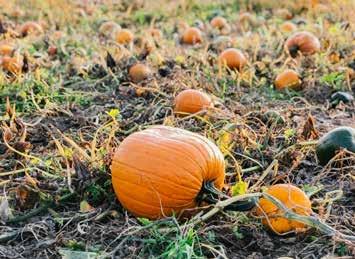
2 minute read
Plant Based Meals
Flexible and Fast
Plant-Based Meals
WRITTEN BY DEB CZECH, PLANTEDPLATTER.COM

As the lazy days of summer taper off and fall arrives, the new season brings some hustle into many households. Whether due to family members heading back to school or the change in temperatures and daylight hours, fall sends us into the kitchen in a new way, ready for different types of meals. Vegetable and grain-based bowls can be a flexible and healthy way to assemble a quick lunch or dinner, allowing each person to build their own meal from a variety of choices. While a simple equation for a grain bowl often calls for “a grain + a green + a bean,” it’s fun to add more flavors as well. In the home kitchen, some simple advance work will go a long way toward streamlining these colorful, plant-powered meals. By preparing ahead of time, you’ll avoid the temptation to yield to less healthy options when life gets busy.
STREAMLINING PLANT-BASED MEAL PREP
1. Prep and Cut the Veggies: Set aside time on the weekend or in advance of the dinnertime rush-hour to wash and pre-cut ingredients like carrots, celery, cucumbers, and peppers. Cut up and steam vegetables like cauliflower, broccoli, or sweet potato. These prepared vegetables can be used in grain bowls and a variety of meals, including pasta dishes, stir-fries, soups, and salads. Short on time? Cook up a bag of frozen mixed vegetables and you are all set with a colorful, nourishing mixture. 2. Batch-Cook Grains & Beans: Whole grains are not hard to make; they just take some time. By preparing grains like rolled or steel-cut oats, brown rice, and quinoa in advance of when you need them, they’ll be all ready to use for breakfast, lunch, or dinner. Oatmeal with fresh fruit makes a heart-healthy, fiber-rich breakfast. Quinoa, rice, and other grains can be the foundation for grain bowls or let them add substance to soup or stew. While dried beans are wonderful to cook with, most require advance soaking and longer cooking times; with limited time, purchase prepared canned beans that only need to be rinsed before they are all ready to go. 3. Prepare Dressings or Sauces: If you’d like a more flavorful alternative to store-bought salad dressings that are often high in fat, sugar, and salt, try making your own. Recipes abound online. These are useful not only for grain bowls and salads, but also to add flair to cooked vegetables and pasta dishes.
For more ideas on assembling grain bowls, visit plantedplatter.com. To build your knowledge of plant-based cooking and nutrition, join Deb Czech for an upcoming class. Planted Platter’s fall schedule of a dozen Zoom cooking events is on the website. SF










